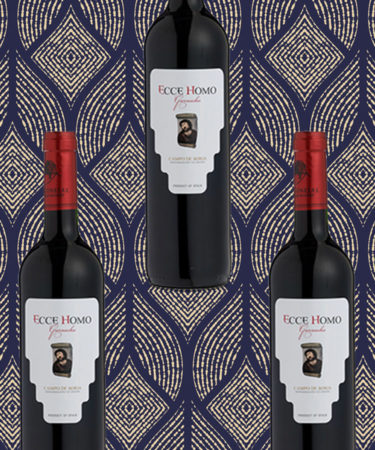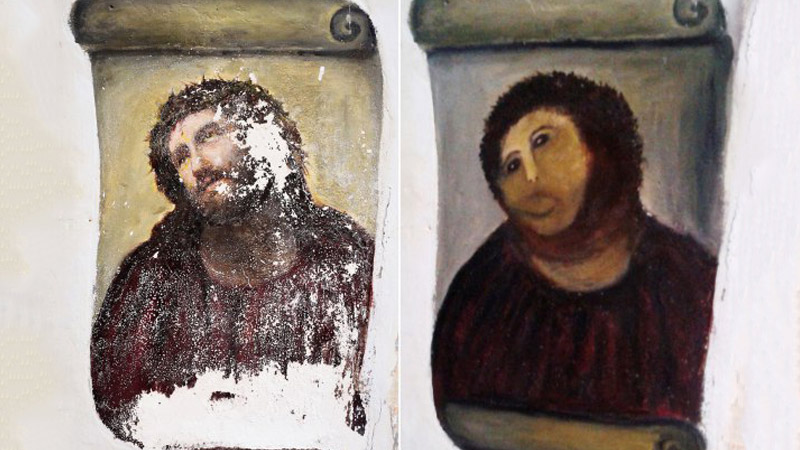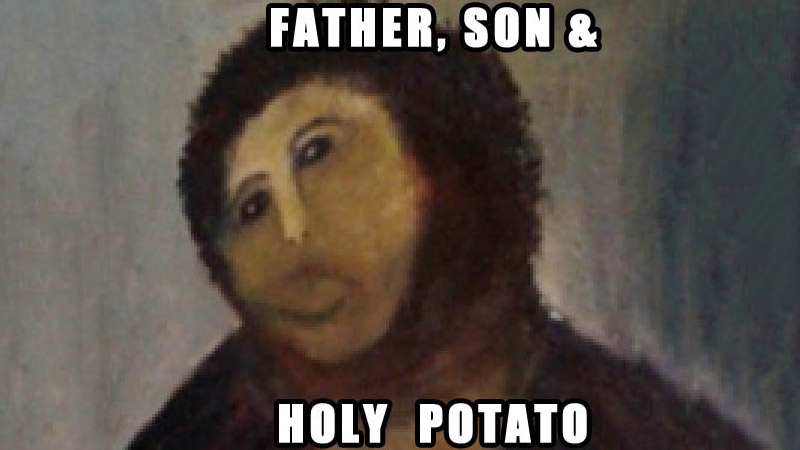Beauty may be subjective, but when an amateur artist in Borja, Spain single-handedly ruined a painting of Jesus Christ beyond repair in 2012, it was obvious.
We’ve all made mistakes in public, but this one was bad — really bad. Until it wasn’t. In fact, this error transformed an obscure work of art into an international icon, a tourist destination, a popular meme, and an award-winning wine.
Cecilia Giménez, the amateur art restorer in question, was 81 years old when she attempted to restore the flaking fresco called “Ecce Homo,” or “Behold the Man,” which had adorned a wall of the Santuario de Misericordia Church (Sanctuary of Mercy Church) in Borja since 1930.
By the time she smudged his mouth, flattened his nose, and turned his tragic thorn crown into a furry helmet attached to a neckbeard, the Son of God was wholly unrecognizable. Many likened him to a monkey, or a potato.
Flash-forward to 2016, when more than 160,000 people had visited the 5,000-person town of Borja to see Giménez’s disfigured fresco. “Ecce Homo the Botched” — or, as the internet lovingly anointed it, “Ecce Mono” (“Behold the Monkey”), or “Potato Jesus” — saved this small town from Spain’s economic recession.
“Ecce Homo” now has its own museum, comic opera, and a plethora of merchandise, including T-shirts, coffee mugs, and teddy bears. And the aforementioned wine? Apparently it’s very good.
Produced by Bodegas Aragonesas in Campo de Borja in Spain’s Aragon region, the Garnacha is praised for its rich and intense cherry flavors, and was even awarded a silver medal at the Mundus Vini Grand International Wine Award Spring 2016 tasting. At an average price of $5 a bottle, it’s a steal — and it’s captured the hearts of wine drinkers the world over.
“The level of these numbers [of tourists] … has never happened before,” Elena Aznar Martinez, who handles marketing for “Ecce Homo,” told the New York Post.
Meanwhile, Giménez, now 87, has become a local celebrity. “The visitors recognize me,” she said. “They take photos with [the painting] and with me.” Prior to her celeb status, Giménez couldn’t eat, couldn’t sleep, and was seeing a psychiatrist to help her cope with the humiliation. Nowadays, her outlook has changed. “Now, I look [at the painting and think,] ‘It’s O.K., you’re not that ugly.’ I hold it so dear — to the point that I see him as handsome!”
Giménez’s grotesque restoration has garnered profitable change in Borja. The church charges visitors 1 euro. All proceeds reportedly support a nursing home affiliated with the church, as do 51 percent of merchandise sales. The remaining 49 percent of souvenir profits go to Giménez, who is using the money to care for her son, who has cerebral palsy.
Painting: ruined. Wine: surprisingly delicious. Faith in humanity: restored.


